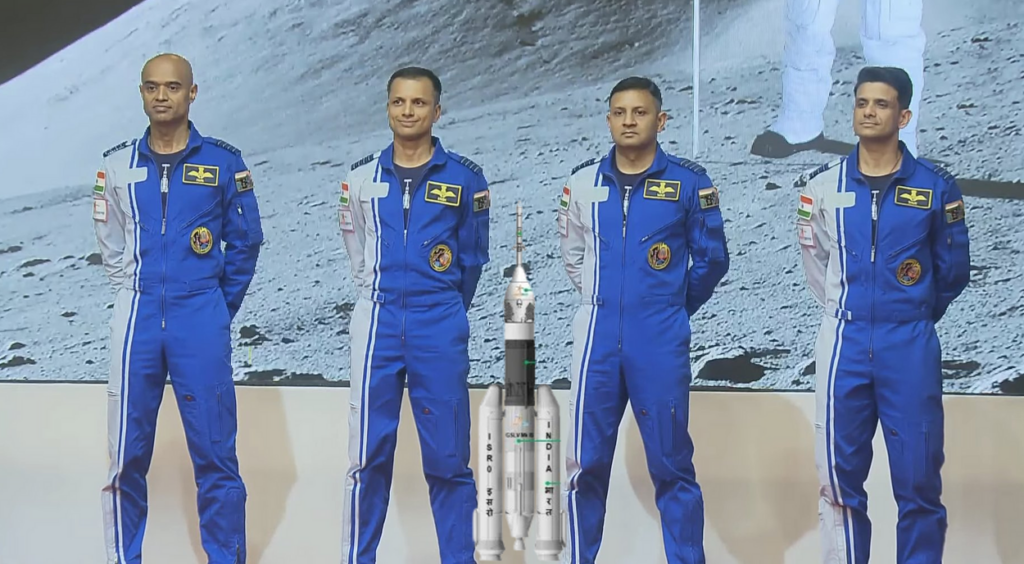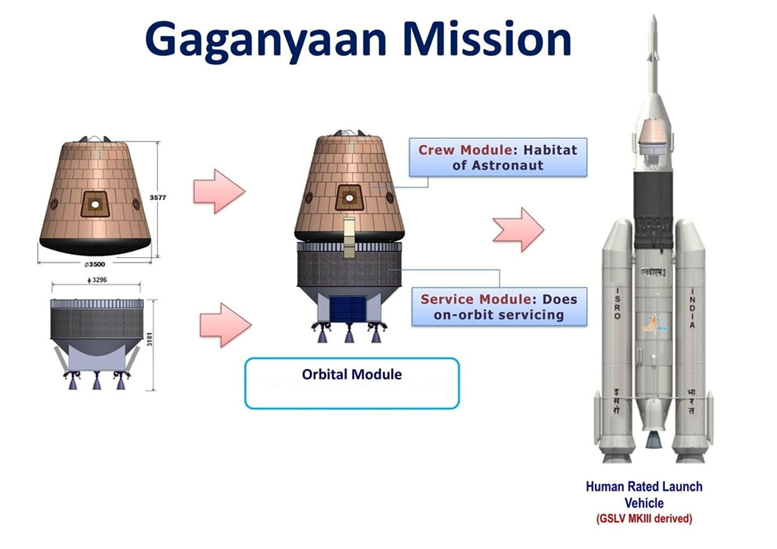|
Getting your Trinity Audio player ready...
|

- The success of Gaganyaan would mark India as the fourth nation to achieve human spaceflight capability, following Russia, the US and China.
- The renowned Indian LVM3 rocket, previously utilised for the Chandrayaan-3 mission, will serve as the launch vehicle for the Gaganyaan mission.
- The human spaceflight programme has many tangible and intangible benefits as it holds potential for scientific research and advancements.
- The challenges associated with manned missions include optimum space transportation systems, crew safety and training, and the creation of an earth-like environment among others.
The Gaganyaan project aims to send a team of astronauts into space, orbiting 400 km above Earth for a three-day mission, and safely return them by landing in the Indian Ocean. According to ISRO, the key elements needed for the Gaganyaan mission include developing critical technologies like a safe launch vehicle for astronauts, a life support system to keep them comfortable in space, a way for the crew to escape in case of emergency, and plans for their training, recovery, and medical care.
The Gaganyaan project, named after the Sanskrit term for a vehicle to the sky, has been developed with an investment of $1 billion. Its success would mark India as the fourth nation to achieve human spaceflight capability, following Russia, the US and China.
Trials Before Gaganyaan Mission
ISRO has been conducting various tests in preparation for the upcoming mission, and in a significant one that took place in October last year, they successfully demonstrated the crew’s ability to safely evacuate the rocket in the event of a malfunction. Following this achievement, the space agency announced plans for a test flight in 2024, where a robot will be sent into space, paving the way for human astronauts to embark on their journey in 2025.
Vehicle Carrying The Astronaut
The renowned Indian LVM3 rocket, previously utilised for the Chandrayaan-3 mission, will serve as the launch vehicle for the Gaganyaan mission. It consists of a Crew Escape System (CES) as well as an Orbital Module along with solid, liquid and cryogenic stages. According to ISRO, HLVM3 will have the capability to launch the Orbital Module into the intended Low Earth Orbit of 400 km. It will consist of:
- Crew module – spacecraft carrying human beings.
- Service module – powered by two liquid propellant engines.
- It will be equipped with emergency escape and emergency mission abort.
Astronauts Shortlisted for the Gaganyaan Mission
Four Indian Air Force test pilots have been shortlisted for the mission. They are: Group Captain Prashanth Nair, Group Captain Ajit Krishnan, Group Captain Angad Pratap and Wing Commander Shubhanshu Shukla
Group Captain Prasanth Balakrishnan Nair is the seniormost IAF official among the four shortlisted for the space mission. Born in Thiruvazhiyad, Kerala, on August 26, 1976, Group Captain Nair is a Cat A Flying Instructor and a test pilot with approximately 3,000 hours of flying experience, said sources aware of developments. He has flown a variety of fighter and transport aircraft, including Su-30 MKI, MiG-21, MiG-29, Hawk, Dornier, and An-32, after getting commissioned on December 19, 1998, in the fighter stream of IAF. The Group Captain has commanded a premier fighter Su-30 Squadron. Nair is also an alumnus of the United States Staff College and a DS at DSSC, Wellington and FIS, Tambaram.
Group Captain Ajit Krishnan, born in Chennai, on April 19, 1982, was decorated early in his career, having got the President’s Gold Medal and Sword of Honour at the Air Force Academy. He was commissioned on June 21, 2003, in the IAF’s fighter stream. An alumnus of the National Defence Academy (NDA), he is the second most experienced pilot after Group Captain Nair who has done about 2,900 hours of flying. He worked as a Flying Instructor and a Test Pilot. Krishnan has flown a variety of aircraft, including Su-30 MKI, MiG-21, MiG-21, Mig-29, Jaguar, Dornier and An-32. The Group Captain is also an alumnus of DSSC, Wellington.
Group Captain Angad Pratap,42, is a Flying Instructor and a Test Pilot, with approximately 2,000 hours of flying experience. He was commissioned on December 18, 2004, in the fighter stream of IAF after passing out from the NDA, said sources. Like his senior colleague, he too has flown both fighters as well as transporter aircraft, including Su-30 MKI, MiG-21, MiG-29, Jaguar, Hawk, Dornier, and An-32. The Group Captain was born in Prayagraj, Uttar Pradesh, on July 17, 1982.
Wing Commander Shubhanshu Shukla is a Fighter Combat Leader and a Test Pilot with approximately 2,000 hours of flying experience. Born in Lucknow on October 10, 1985, he went to the NDA and was commissioned on June 17, 2006, in the fighter stream. Among the aircraft he flew so far include Su-30 MKI, MiG-21, MiG-29, Jaguar, Hawk, Dornier, and An-32.

Crew training for Gaganyaan
The four astronauts who will be a part of the Gaganyaan spacecraft scheduled for launch in 2024–2025 were trained in Russia for 13 months and underwent generic space flight training at Yuri Gagarin Cosmonaut Training Center in Star City, about 30 km north of Moscow. It is the same centre where Rakesh Sharma — the first Indian to go into space in 1984 — was also trained.
Astronaut Training Facility established in Bengaluru caters to Classroom training, Physical Fitness training, Simulator training and Flight suit training. Training modules cover academic courses, Gaganyaan Flight Systems, Micro-gravity familiarization through Parabolic Flights, Aero-medical training, Recovery & Survival training, mastering of Flight Procedures and training on Crew Training Simulators. Aeromedical training, Periodical flying practice and Yoga are also included as part of the training.
Significance of the Gaganyan Mission
The human spaceflight programme has many tangible and intangible benefits as it holds potential for scientific research and advancements. These scientific research and advancements can have far-reaching implications, benefitting not only India but the entire global scientific community.
- To achieve future technological capability: The success of the Gaganyaan project is expected to inspire further affordable human space programs to explore the solar system and beyond, sample return missions, and other scientific exploration.
- A unique opportunity to inspire Youth: Expected milestones of Gaganyaan will inspire students toward careers in science and technology towards challenging jobs that would encourage innovation and creativity, particularly in the field of space science.
- Potent foreign policy tool: It will open doors for diplomatic collaborations with other spacefaring nations, paving the way for joint missions, knowledge exchange, and international cooperation in space exploration thereby strengthening international partnerships.
- Scientific breakthrough: Scientific experiments in a microgravity environment facilitated by Gaganyaan can lead to groundbreaking discoveries in fields like medicine, material science, and biology.
- Economic growth and employment generation: Gaganyaan’s mission can stimulate economic growth through the development of space-related industries, technology spin-offs, and job creation, contributing to India’s overall development.
Challenges with the Gaganyaan Mission
The challenges associated with manned missions (Gaganyan) are far higher than those faced by unmanned ones. Major challenges before space-based missions are space transportation systems, crew safety and training creation of an earth-like environment among others.
- Reliance on Indigenous Technology: The Gaganyan programme largely depends on indigenous technology, which requires complex research, development, and testing of new complex technology to ensure the safe execution of programmes.
- Space Transportation Vehicle: While the requirement is to send rockets that are light in weight, putting humans in space requires heavier rockets. Hence, the development of customized launch vehicles that can carry loads more than communication satellites is challenging.
- Complex Training and Simulation: India lacks major critical space training and simulation facilities for manned missions. Hence India’s dependence on other space agencies or nations (US and Russia) for such facilities.
- Regenerative Environment: Due to the limitation of carrying much weight into space, a regenerative environment for food, water, oxygen, carbon-di-oxide and human waste has to be developed.
- Creating an Earth-like Environment: Testing all support systems of the Gaganyaan in an actual operating environment is next to impossible. Hence, the creation of an atmosphere like Earth inside a small crew module remains a challenging task.
- Crew Safety: It is the most sensitive part of the Gaganyaan project. Crew may encounter depression, Radiation exposure, fatigue, sleep disorders and psychiatric disorders in a zero-gravity environment.
(Guruprasad is a technologist working in a reputed telecommunications company in Bengaluru. He writes on advances in science and technology. Opinions expressed are the author’s own)

India’s space ambitions have seen an unprecedented success and increase under PM Modi. We are sure that Gaganyaan will be a roaring success, proving the mettle of our scientists and engineers. The article is a good reference on the mission.